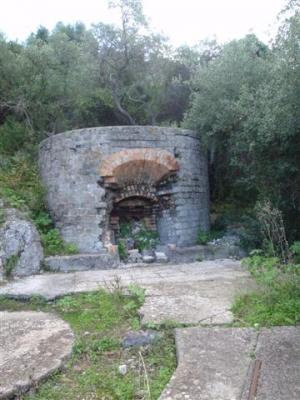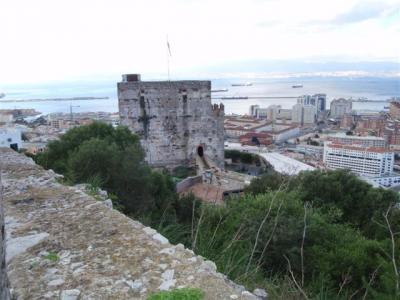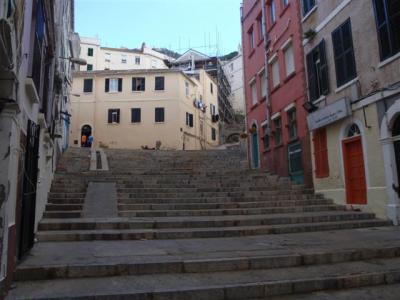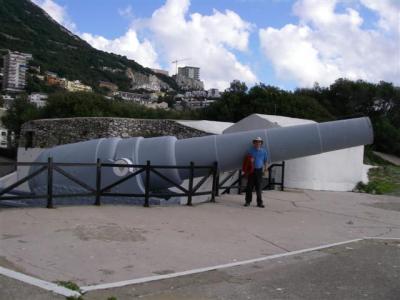Continued from yesterday”¦ As we were leaving the Siege Tunnels, the driver suggested that we walk down the hill so we could stop at two more sites, the City Under Siege display and the Moorish Castle. The site we wanted to see most, the WWII tunnels, was also on the way down, but it just happened to be closed for the day. Here is a mamma and baby monkey hanging out near the tunnels.

We passed the last remaining lime kiln in Gibraltar. Lime was heavily used up through the late 1800’s. It had many purposes, which were not detailed other than to mention that water cisterns were painted with it to keep the water bacteria free and it was dumped into the graves of people who died of some contamination to keep the contamination from spreading. Interesting. A secondary reason we put this photo in so you can get an idea of what the foliage is like on the rock.

The Siege exhibit is housed in some of the first buildings the British put up in Gibraltar after taking it over, originally intended for gunpowder storage. The exhibit is small, but remarkably well done. There are signs describing the horrors the people had to suffer, with mannequins depicting the struggles described. Over 7,000 people were living in Gibraltar during the siege. Because they were living in confined, unsanitary conditions, disease was rampant. More soldiers died of disease than combat. There were minimal medical facilities and no nurses. The soldier’s wives tended to the sick and injured. The wives got no food rations. Civilians lived on grass, seaweed and wild onions. Occasionally, food would be smuggled past enemy lines from North Africa, but this black market food was unbelievably expensive. For example, a head of cabbage cost two days wages. Scurvy was rampant. Those in charge of keeping order were ruthless and liked to whip people who got out of line with 9 tailed whips. The Spanish kept hitting the city with cannonball fire. All in all, 400 houses were destroyed, and almost every house sustained damage. To escape the bombardment, the people abandoned their houses and lived in tents outside the city.
After the exhibit, we headed down to the Tower of Homage, part of the castle you can see ½ way up the hill from the waterfront. It was built in 1333 over a demolished tower that dated back to 1160. It was built by the Moors, and with its enormously thick walls has withstood 10 sieges. It is 23 meters tall and stands 100 meters above sea level. In addition to defense, it was a great spot to monitor shipping traffic. At the bottom of the tower is the Moorish Castle, and until the British remodeled it, the only access was from the castle. Here is a photo from farther up the rock. It is the blocky thing in the center of the picture. You can see the courtyard and entrance clearly. In the background you can see some of the waterfront development and ships anchored out in the bay.

There is a small courtyard around the entrance of the tower. From the courtyard there is a nice view. Up close, you can see all the indentations from canon balls that have hit it. This entrance is the one the British made. The entry level is little more than a stairwell. The downward steps that lead to the castle are blocked off, and our only choice was to go up. The actual living area we saw was quite small, each floor consisting of a few empty rooms. The sign said that in times of emergency a bell would ring and all the townspeople would head to the tower for safety. It was intended as a last resort temporary refuge, not to be lived in, although one room was specifically used for washing and has drains. It is not all that exciting. After a couple floors we came to the roof, a flat open air patio where you can see the marks from where canons used to be mounted.
Shortly after leaving the castle, we saw a set of stairs that we assumed led down into the city. We passed by a lot of buildings on the way down, and they looked to primarily residential. Some are well maintained and look nice. Others are in bad shape and desperately in need of work. Many are currently being renovated, some of them extensively. This area doesn’t exude the same quaint charm that the center of town does. Within a few minutes we were on the main drag.

We headed south to go see the 100 ton gun. A gun that heavy is unimaginable. That is 4 Kosmos, fully loaded with fuel and water! The person who gave us directions told us it was a 15 minute walk along the road that parallels the water. He also told us it doesn’t ever get any colder than it did yesterday. Today it is 17 degrees Celsius, plus the wind chill factor, and it is definitely warmer than yesterday.
It turns out two roads parallel the water, a higher one and a lower one. We picked the lower one. We picked the wrong one. After 15 minutes of walking, it dead ended. We had to turn around, walk almost back to town, and retrace our same steps on the upper road. It looks like where the canon is housed is a small military outpost. The gun and gun museum seem to take up the majority of the visible space, although there is apparently an underground complex, as well. What is now the gun museum was the storage and staging area for the shells and explosives.
The gun was installed in 1883. It was delivered via boat. It took the soldiers three weeks to move it 1/3 of a mile to its current spot. Since it was so difficult to maneuver and load, a sophisticated hydraulic system was devised. It took three hours to build up enough hydraulic pressure to get the gun loaded and aimed. But since most ships came by sail and you could see them well before they arrived, three hours was still plenty of lead time. It took 23 people to operate it, and it was hot, dirty work. In addition to the 23 operators, support personnel, like rangefinders and trumpeters were also needed. The gun had some revolutionary features at the time. For example, the fuse was lit using electricity, not matches.
Each shot took 450 pounds of gunpowder. The shells weighed 2,000 pounds and left the muzzle at a speed of 1540 feet per second. The gun’s range was 5 miles, though the accurate range limit was only 6500 yards. There were four kinds of shells, and one of them was armor piercing. It was designed to fire a round every four minutes, but the crafty British figured out how to get it down to 2.5 minutes. After practicing with rounds at the new and improved speed, the barrel split. The barrel was quickly replaced. With the rapidly changing technologies of the late 1800’s and early 1900’s, the gun was rendered obsolete before it had ever fired a single shell in combat. This is a full size model of the bullet.

After browsing the museum, we went outside to see this legendary piece of artillery. It is certainly large. Four anti-aircraft guns were installed next to the gun during World War II, one still stands on exhibit next to the big gun.

We decided we did enough walking for one day and caught the bus back to the marina. We have been spoiled because lately most of the places we have been to have busses and trains every few minutes, but here we had to wait an hour. The bus drove us through some areas we haven’t seen yet, which were interesting to see, particularly the new places on the man made land.
